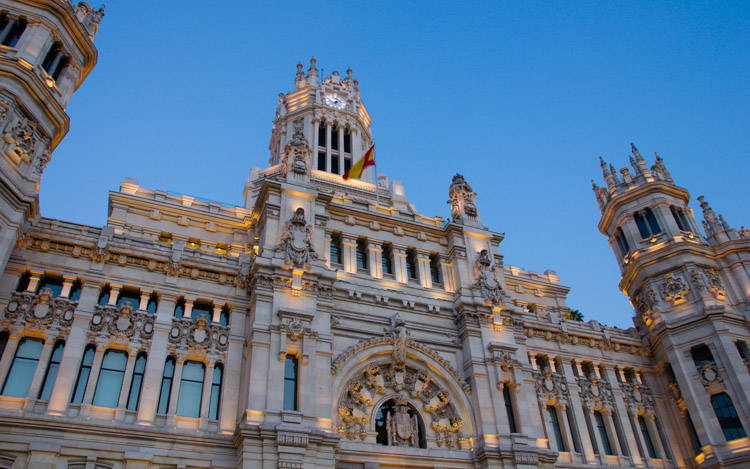
The Prado Boulevard is one of the most interesting areas to visit in Madrid, it has lots of monuments and museums that you can not miss while in Spain.
History of the Prado Boulevard
‘Prado’ means meadow in Spanish. In the mid-fifteenth century Puerta del Sol was of the boundaries of Madrid and was where the eastern entrance was. Beyond this point all there was were orchards, groves and streams.
In 1505 the Convent of Saint Jerome was built, funded by the Catholic Monarchs. They had a chamber there and occasionally came to rest.
After the Felipe II ordered, in 1561, the capital to be moved to Madrid, the city grew rapidly; El Prado became very popular and heavily populated by carriages driving along it.
In 1631, under Felipe IV’s order, the Retiro park and Palace were built, the park was for the exclusive use of royalty, so that the nobility and the common people continued moving through El Prado. Throughout the eighteenth century many palaces and villas of the aristocracy sprouted up in the area.
However, the real transformation that formed the Paseo del Prado as we know it today was conducted during Charles III’s reign. This king arrived in Madrid from Naples and did not like the change, he considered the city to be dirty, unsafe and unworthy to be the capital of the kingdom. He carried out endless urban improvements, which earned him the nickname “The best mayor of Madrid “. Notable among these improvements are the Paseo del Prado, a place for recreation outside of Madrid.
Monuments and Museums in the Paseo del Prado
Saint Jerome Royal Church
The architect Enrique Egas based this on models of Saint Thomas in Avila and San Juan de los Reyes in Toledo, but with a Madrid-style, brick and masonry.
Because of the Independence War and the later ‘Ecclesiastical Confiscations of Mendizabal’ the temple has suffered great damage and had subsequent amendments. Currently the original Renaissance-Gothic building is complemented by neogothic additions, like the pediment and the towers.

Prado Museum
This building was designed by Juan de Villanueva. Charles III wanted this to be built in order to house the Cabinet of Natural History and Science Academy. However, after the king’s death, it remained unfinished, being dismantled by the French troops during the war of independence.
Under the reign of Fernando VII, and thanks to the work of his wife Isabel de Braganza, the museum was opened in 1819 as the Royal Museum of Paintings.
? Read more about the best museums you can visit in Madrid
Royal Botanical Garden
Opened in 1781 by Charles III, he ordered all possible species from overseas to be brought here so he could study them.

Astronomical Observatory
Another work ordered by Charles III in an effort to concentrate sciences on the Paseo del Prado. The building is also the work of Juan de Villanueva and was completed in 1795.
Reina Sofia Museum
The space now holds a contemporary art museum and was originally a School of Surgery and a hospital.
Monumental Fountains
Part of the project from Charles III, for the embellishment of the area, Ventura Rodriguez designed a set of fountains: Cibeles, Neptuno, Apolo, Cuatro Fuentes and Artichoke.

Atocha Station
This train station is representative of the unique iron and glass architecture of the late nineteenth century. The previous station has linked Madrid with Aranjuez since 1851. Queen Isabel II inaugurated the first trip.
Communication Palace
In 1919 the works of this unique building were finished. Its functional character, for public use, has not prevented it standing out as one of the most monumental edification in Madrid.
? How to visit the rooftop at the Communications Palace

Palace Hotel
Alfonso XIII had it built and opened in 1912. Its walls have thousands of stories to tell and it has hosted the most prominent of guests. When it started out, it was the only hotel in Europe with a private bathroom and telephone in every room, luxury at the time, it’s still today a symbol of splendour.
? Best hotel locations to stay in Madrid

Ritz Hotel
Two years older than the Palace Hotel, the hotel also performed at the behest of Alfonso XIII, looking for the luxury of their counterparts in London and Paris.
National Bank of Spain
The current building was opened in 1891, but the National Bank of San Charles, its predecessor, has existed since 1782. The Chamber of Gold, 35m underground, is one of the most curious elements.
? Fun facts about the National Bank of Spain
Palace of Stock Exchange
It was opened in 1893, but the stock market had been created 62 years earlier, having had several previous sites, before this magnificent neoclassical building was erected.
Thyssen-Bornemisza Museum
The old Palace of Villahermosa now houses an important collection that complements movements and styles of antique painting collections of the Prado Museum, and from Reina Sofia modern paintings.
Caixaforum
Its building and garden stand upright on the Art Boulevard. Industrial architecture adapted to a new use, the former power station has become a modern cultural center that houses temporary exhibitions.


